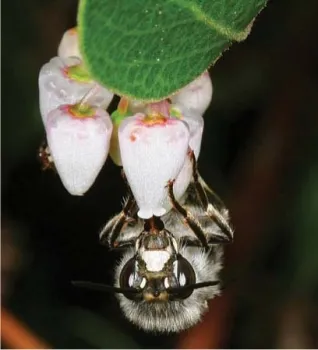
Getting to Know Our Native Bees 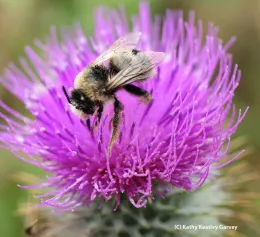
Encouraging healthy bee populations has long been part of the Master Gardener mission. In our study of Integrated Pest Management (IPM), we learn that chemical pesticides can do harm to entire food chains, from plants to insects, and other wildlife. With bee colony health very much in the news, many gardeners are surprised to learn that in addition to the European honey bee, California is home to hundreds of species of native bees, many of whom reside in solitary nests, hidden in plain sight around our gardens. On a recent walk through a local apple grove, I was excited to identify four – maybe five types of native bee hovering in the blossoms alongside the honey bees. We know that plants and bees rely on one another for their existence. Recent studies published by the UC Cooperative Extension can help us recognize our native species, and help raise awareness about preserving bee habitats.
I.D. The Bees
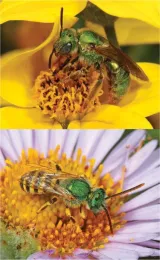
Of the native bees counted, the most common was the ultra-green sweat bee (left)(Agapostemon texanus). To spot this bee it's important to look closely. With its slim shape and smooth green body, the sweat bee can be mistaken for a fly. Photos from the UC study by Rollin Coville (©2009) show a female ultra-green sweat bee (above, left) and a male (below, left) as they feed on native blooms.
Another common visitor, the leaf-cutter bee (below, right) (Megachile perihirta) has a distinctive mandible designed for chomping leaves and stems.
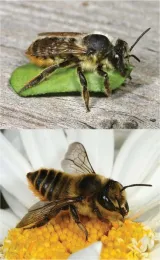
The digger bee (shown below, left and at the top of the page)(Anthropora edwardsii) is prevalent in Southern California and is specifically adapted to the tiny flowers of the manzanita (Arctostaphylos sp.). Like many native bees, the digger bee is solitary. The female prefers dark quiet places to lay her eggs, and makes her nest in the ground, or in dead wood.
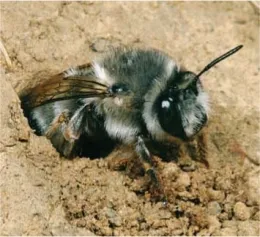
Female bees of most native species, unlike their male counterparts, have specially formed hind legs made for gathering pollen. During springtime's brief blooms, native bees can be seen going from flower to flower loaded up with the golden powder. The solitary bee (below) (Svasta obliqua expurgata) is a muli-tasker at the coneflower (Echinacea pupura), simultaneously sipping nectar and gathering pollen.
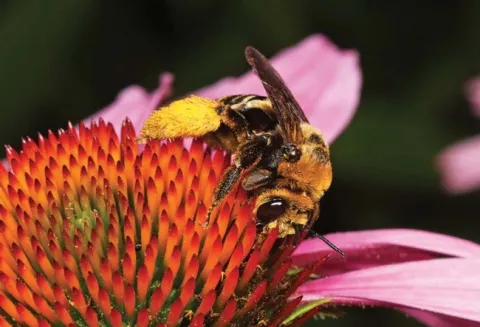
Native bees to look for this spring include those most common in the study: mining bees (Andrena angustitarsata); digger bees (Anthrophora); and three bumblebee varieties (Bombus), California, black-tip and yellow-faced. Others bees found include carpinter bees (Ceratina); gray digger bees (Habropoda depressa) and long-horn digger bees (Melissodes), as well as squash bee (Peponapis pruinosa); cuckoo bees (Xeromelecta californica); large carpenter bees (Xylocopta tabaniformis incompletes); leafcutting bees (Megachile); mason bees (Osmia coloradensis); and the blue orchard bee (Osmia lignaria propinqua).
The Xerxes Society's The Citizen Scientist Pollinator Monitoring Guide was created to help communities survey pollinator populations at the local level. The user-friendly guide (downloadable pdf) helps gardeners learn the basics about bees, identify different varieties, and track their activities, over time.
The full study Native Bees are a Rich Resource in Urban California Gardens is available online through UCANR. It details some of the native plants that attract native bees (California Agriculture 63(3):113-120 (2009)):
http://calag.ucanr.edu/Archive/?article=ca.v063n03p113

